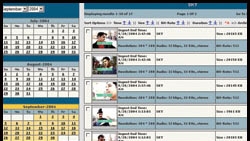Beehive Systems' Tx'log puts information at the finger tips

Tx’log allows the logged video to be viewed on any standard PC using a Web browser application such as Internet Explorer.
As broadcasters grow from one channel to multiple channels and from limited program content to 24×7 programming, the process of logging the content has to be cost-effective, simple, reliable, fast and accurate. Analog systems, usually ranks of VHS recorders, do not scale easily.
The answer lies in digital logging of the content. Not only can it be cost-effective, but also it is much easier to log, search and view the archive.
There are several reasons to deploy a logging system. Originally, such a system has been used as a record of program transmissions in order to comply with government regulations and as evidence of aired commercials. New, lower-cost digital systems present new applications.
One application is an online archive for staff to browse past programs. Another is to monitor competing stations as a research tool.
Tx'log from Beehive Systems is a disk-based, 24×7 digital logging system. It keeps a frame-accurate, continuous video log of the aired content. The company uses MPEG-4 encoding for improved compression efficiency. Rates of 40kb/s up to 1Mb/s can be used, depending on the viewing quality requirements. All recordings are segmented and indexed with basic metadata attached automatically and are made available for remote browsing immediately. Clip duration is user-configurable from 15 seconds to 30 minutes.
Storage is provided by up to four 80GB disks. Storage redundancy is provided by a spare drive with an option of RAID-3.
The professional video industry's #1 source for news, trends and product and tech information. Sign up below.
Once programs have been encoded, it is possible to locate clips using the search facility from a standard PC using a Web browser such as Internet Explorer. Clips can be located by channel, date and, if present, metadata. The system displays search results from the relevant clips logged and plays the desired segment. The clip duration can range from 15 seconds to 30 minutes.
Analog logging with videotapes needs a tremendous amount of manpower and results in recurring maintenance costs. One needs thousands of tapes to record video on a daily basis. The tapes need manual handling. In the long-term, they need to be cared for in order to avoid damage and loss of data.
Unlike earlier tape-based systems, Tx'log provides instant access for airtime marketing personnel in the station via a Web-based search engine. The staff, therefore, can send a video log with the date and time stamp to the advertisers, thus serving as material evidence of their commercial having been aired. With zero frame-drops, this product ensures that the advertisers are provided with an on-demand reference to all their commercials.
Rashmi Jaju is manager, marketing-communications, for Beehive Systems.
Table 1. A comparison of analog logging versus digital logging ANALOG LOGGING DIGITAL LOGGING Needs large storage space Significant amount of data can be stored on a small server Not accessible to multiple users (need to make multiple copies) Can be accessed by multiple users at the same time without creating extra copies Searching for wanted clips a lengthy process Metadata attachment (date, time, origin) makes search and retrieval easy Needs constant maintenance as data is prone to generational loss due to copying Because data is digitally logged, no quality check or maintenance is required Dubs cannot match the quality of master Copies are clones of master High overhead, maintenance and administration costs Low maintenance and administration costs
